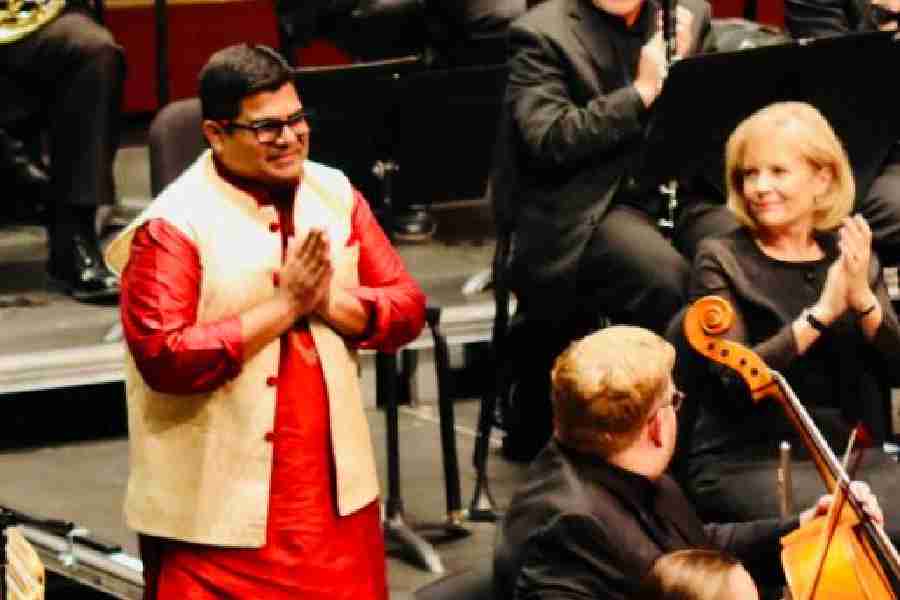Indian-American tabla artiste Sutanu Sur cannot contain his excitement. Not because he is collaborating with prominent Indian-American composer Reena Esmail for the third time now. On June 25, it is going to be the first time that the Indian tabla will feature at the Green Lake Festival of Music in the US since its inception in 1979.
Sur recently played along with his 11-year-old daughter, Sumedha Sur, who is a violin player, at an event organised by Fox Cities Performing Arts Center and IndUS of Fox Valley on the occasion of World Music Day on June 21.
In an exclusive chat with t2, the 38-year-old North 24-Parganas boy who is currently a Wisconsin resident and an engineer by profession, talks about Indian music, the US, and more…
This is for the third time you’re going to collaborate with the acclaimed international composer. How excited are you?
Absolutely! In my first work with her, I had a chance to perform along with the Fox Valley Symphony Orchestra in October last year. That concert was significant as it was a full house after two years of Covid. My performance was appreciated by none other than Dr Kevin Sütterlin. The opening night of the Fall concert began with me demonstrating tabla to the audience at the pre-concert talk. We received an overwhelming response. Notably, this was the first time ever in the history of the Fox Valley Symphony Orchestra that an Indian instrument was played.
Then my second collaboration with her happened at the Major Works concert, which gave me a wonderful opportunity to play alongside the Lawrence Symphony Orchestra in April this year. It was a one-of-a-kind concert on Reena’s composition This Love Between us: prayers for unity, comprising seven movements for seven religions in India. Around 200-plus musicians came together for the concert. We received a standing ovation from the audience after this performance. And I had many music lovers come to me and express their interest in getting tabla lessons from me.
Reena is the composer-in-residency for the upcoming Green Lake Festival of Music happening on June 25. As a featured tabla artiste, it would be my privilege to mentor the musicians and train them on how to perform alongside tabla, and introduce them to the concept of ragas and taals, the fundamental elements of Hindustani classical music. At the pre-concert talk, I will walk them through the journey of Indian classical music and demonstrate the rhythmic cycles of the tabla.
Can you tell us a bit about the piece you’re going to play at Green Lake Festival of Music?
The theme is Hemispheres Uniting and my piece titled The Tipping Point will offer a unique musical experience as it will act as a transition point between Western and Indian music. It will also serve as a metaphor for the solstice, holding a mirror to the social struggles against injustice, which is akin to the cycle of light and darkness. As far as the technicalities of the performance of Indian classical music on the stage are concerned, we improvise a lot on stage. When we play the tabla with the sitar, there is a continuous collaboration taking place, and accordingly, we set the taal and the tempo. For these collabs, we decide on the taal beforehand. When I play the tabla on a particular piece, that, let’s say, has four cycles of taal, I get a limited time frame within which I have to improvise, giving the audience a taste of the different flavours of taal. As we get towards the end of the composition, the rhythm will change and I will continue to improvise with faster rhythms.
How is the reception of Indian classical music in the US? And is it the same in all parts of the US?
When I first came to the US a decade back, the musicians I interacted with lived with the notion that Indian music and Western music are not at the same level. Now thoughts have changed thanks to technology. In this era of Instagram, we get to collaborate with global musicians in real time. Covid has proved we can survive with this work-from-home culture. Concerts can still happen if you are at home. Now knowledge flows like a river, courtesy of global advancements.
The US is a huge country and we have different communities living here. Indian music is very popular in New Jersey, Texas, and in certain pockets of California — it is primarily because a lot of Indians reside in this part of the US. Wherever you have a substantial Indian population, Indian music finds its audience. In my area, Wisconsin, the midwestern US, our Indian population is comparatively low, and so is the relevance of Indian music in those areas. Again if you take Ustad Zakir Hussain or Pandit Swapan Chaudhuri, they have painted their respective regions in the US with the hues of Indian classical music.
